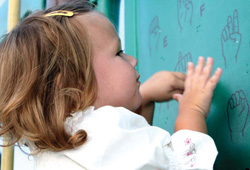Have You Ever Wondered What Your Baby’s Goo Goo’s And Gaa Gaa’s Meant?

Parents often have difficulty understanding exactly what their child needs or wants in their preverbal stage. Not for lack of trying, this barrier in early life can cause frustration in both the parents and the baby. Over the past several years, baby sign language has becoming increasingly popular among parents. Parents all around the world are seeing the huge benefits that signing brings. The number one reason parents sign with their babies is to reduce frustration for both baby and parent. It enables parents and babies to communicate months before their baby can verbally form words and sentences. Just imagine how much less stressful your life would be if you could ask your baby what he wanted to eat and he could easily tell you through the use of a sign. Because you are able to understand your baby’s needs you are able to easily respond to him immediately, eliminating the frustrating guessing game of what your baby wants.
Signing with your baby is as simple as teaching him or her to wave bye-bye. You can learn the signs one at a time with your baby.
There are great books and online resources to help you decide what signs are best for you to start with. The first sign I recommend for parents to teach is ‘milk’. It’s such a huge part of your baby’s day and it’s a simple one for you to remember to do. It may feel funny signing at first because it isn’t something as natural as speaking to you but soon enough it will feel like second nature.
The important thing to remember when signing with your baby is to be consistent with your signs. It is more important to sign one word consistently than a bunch of words randomly throughout your day. It will be much easier for your baby to link the action to the word if you make that action each and every time you say the word.
When signing with your baby don’t hesitate to take his hand and show him how it feels to make it. You will notice that your baby will recognize the sign before he makes it. By taking his hand and making the action you will help him realize that he can make the sign and get the thing he is asking for.
Signing is also a great way to establish routines. If you have a bedtime routine that consists of bath, story and bed you can easily sign ‘bath’ during bath time, then ‘book’ before reading a story, then ‘bed’ before putting your baby down.
By doing this every night your baby will get used to the evening routine. One of my favourite signing stories was around evening routine. The routine was bath, book and bed, which she signed every night. Her baby had yet to sign back, but Mom knew she understood the signs. One evening they came home a little later than normal and Mom decided to skip the bath and just put
the baby to bed.
Baby was fussing and fussing and Mom thought it was because she was overtired. It was at that moment that she noticed her baby was signing ‘bath’ over and over! She wasn’t overtired; she was sad that she missed her bath. Without signing this little one would not have been able to communicate this to Mom, which could have resulted in further fussing and frustration. By signing ‘bath’, the baby was easily able to communicate what she was upset about and Mom could easily rectify the situation!
Signing is very simple to do! The book The Baby Signing Bible has many tips and information on how to be successful at it. You will be very happy when your little one is fussing and you can simply say, “Show me the sign” and you know what the problem is!
Laura Berg is the president and founder of My Smart Hands. She is also the author of The Baby Signing Bible. Laura is a You Tube super star with one of the top 40 most viewed total uploads of all time in Canada with over 20 million views. Visit www.mysmarthands.com or follow her on Twitter: @MySmartHands and Facebook: /MySmartHandsFan.




